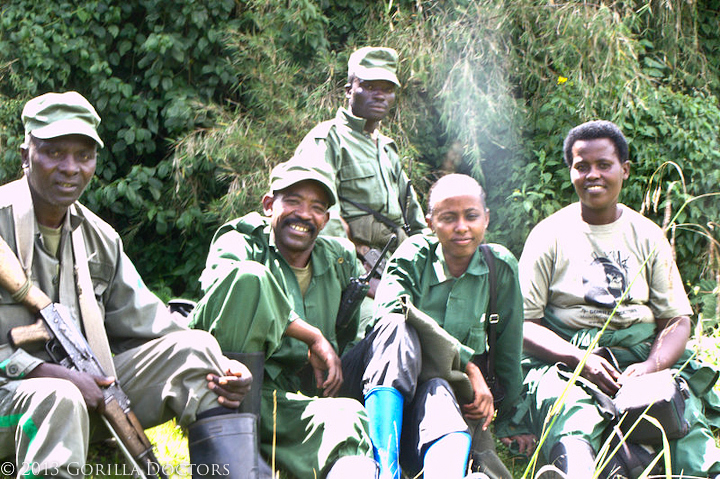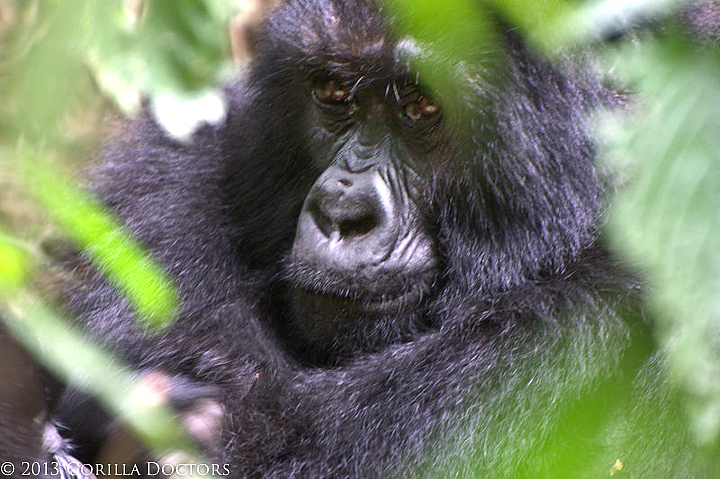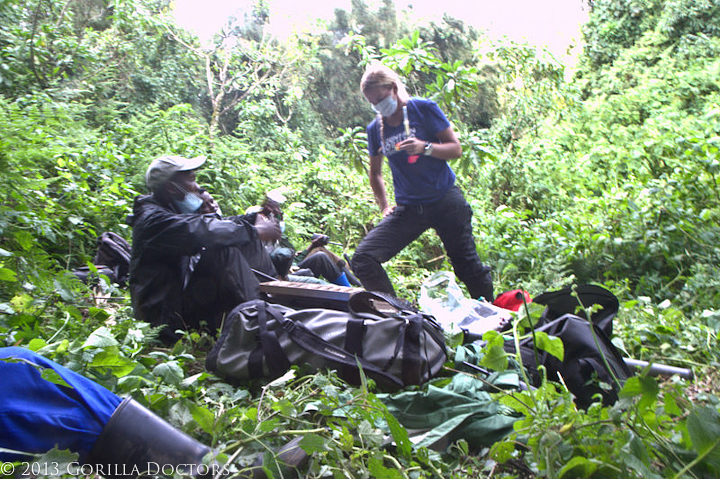Respiratory Disease Outbreak Continues In Sabyinyo Group
By Gorilla Doctors Staff on Saturday, January 26th, 2013 in Blog.By Dr. Dawn Zimmerman
On January 22, Sabyinyo trackers reported that five gorillas were coughing in Sabyinyo group. A veterinary assessment the following day confirmed that six members had been affected by the respiratory disease: Guhonda, Gihishamwotsi, Gukunda, Kampanga, Ishimwe, and Umurinzi.
 Sabyinyo Group trackers with VNP veterinary warden Elisabeth Nyirakaragire.
Sabyinyo Group trackers with VNP veterinary warden Elisabeth Nyirakaragire.
During our recheck of the group on January 24, we found adult female Kampanga was weak with tachypnea; she was darted with antibiotics and a non-steroidal anti-inflammatory. On this day, eight gorillas were thought to be affected, though one individual, Gihishamwotsi, was not found. A search team for Gihishamwotsi and a group recheck by Elisabeth Nyirakaragire (VNP vet warden) was planned for the following day.
By January 25, ten of the fourteen gorillas in Sabyinyo group were affected by the respiratory disease; however, one gorilla Urumuri was not found. Gihishamwotsi, who was previously missing, was found with the group. He was active and eating and his stomach was ¾ full, although was still coughing for the fourth day. He appeared much improved from two days ago, however.
 Adult female Kampanga, who was treated with antibiotics and anti-inflammatory medications.
Adult female Kampanga, who was treated with antibiotics and anti-inflammatory medications.
Kampanga also appeared improved following the intervention to deliver antibiotics and an anti-inflammatory the previous day. She was more active although still a bit weak, and was eating fairly well. Her respiratory rate was still high at an average 40 bpm. In addition, she was still coughing (4th day) but no nasal discharge was observed.
 Umurinzi was coughing for the fourth day in a row.
Umurinzi was coughing for the fourth day in a row.
Ishimwe, Umurinzi and Guhonda were also still coughing (4th day) and had nasal discharge, but remained active and eating. Gukunda appeared worse today: she was coughing more, but still active and eating well. Shirimpumu was also still coughing and mildly lethargic but active and eating; he had a mild elevation of respiratory rate at 30 bpm. Gukunda’s infant, Itabaza, and Umutungo were both coughing for the first time today, but were active and eating well.
8-year-old Icyerekezo was very weak, found in sternal recumbency only one meter from his nest. He was not observed eating or moving by Elisabeth over a few hours of observation. He was approximately 40 meters away from the group. He was coughing occasionally and exhibited tachypnea at an average respiratory rate of 40 bpm.
 Dr. Dawn prepares to intervene to treat Icyerekezo.
Dr. Dawn prepares to intervene to treat Icyerekezo.
During Elisabeth’s assessment of Sabyinyo group, Dr. Noel and I were assessing ailing dominant silverback Urugamba. We quickly trekked down the mountain, drove over to the Sanyinyo area, and back up the mountain arriving around 11:30am. We agreed with Elisabeth’s assessment and due to the severity of Icyerekezo’s clinical signs, darted him with an antibiotic (3.25 g ceftriaxone) and non-steroidal anti-inflammatory (130 mg ketoprofen). At 12:25, Dr. Noel successfully delivered the first of two 5cc darts in the right epaxial musculature. Icyerekezo moved off after the dart and had to be tracked again to deliver the second dart, which was done so at 1:25. During this hour, we were able to collect a fecal on Icyerekezo for respiratory research.
You can follow the Gorilla Doctors health monitoring efforts on our Facebook page, where we post photos and notes from our monthly visits.
Please consider supporting us by making a secure online donation. Every dollar you give goes to directly supporting our gorilla health programs and One Health initiative. Thank you for your generosity.


 Donate
Donate